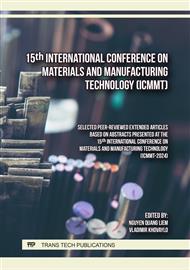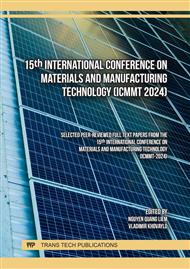p.3
p.9
p.19
p.27
p.35
p.41
p.51
p.59
Assessment of the Influence of Surface Quality on the Bending Fatigue Strength of WAAM Ultra-High-Strength Steel
Abstract:
This investigation evaluates the influence of surface quality on the bending fatigue strength of Wire Arc Additive Manufacturing (WAAM) Ultra-High-Strength (UHS) steel, The study is focused on structural integrity, hardness, surface roughness, tensile strength, and bending fatigue performance. Cross-sectional analysis reveals slight variations in wall thickness, averaging 5.5 mm, with an absence of discernible pores or defects, affirming the process's capability to yield high-quality results. Hardness assessments indicate uniformity across the deposited component, with an average hardness of 303 HV, emphasizing consistent material properties. Surface roughness analysis highlights superior fatigue strength in polished samples compared to machined and as-built ones, with roughness inversely impacting fatigue resistance. Tensile tests confirm satisfactory yield and tensile strength, with favorable ductility characteristics. Bending fatigue tests show that surface quality significantly influences fatigue strength, with polished samples exhibiting the highest fatigue limit. Conversely, as-built surfaces display the lowest fatigue strength due to increased sensitivity to crack initiation, emphasizing the critical role of surface quality in UHS steel fatigue performance. These findings underscore the suitability of WAAM-printed UHS steel for structural applications while emphasizing the importance of surface quality in determining fatigue resistance and overall component performance.
Info:
Periodical:
Pages:
19-25
Citation:
Online since:
September 2024
Authors:
Price:
Сopyright:
© 2024 Trans Tech Publications Ltd. All Rights Reserved
Share:
Citation:



